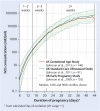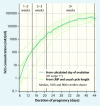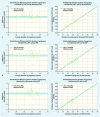Strips of Hope: Accuracy of Home Pregnancy Tests and New Developments
- PMID: 25100881
- PMCID: PMC4119102
- DOI: 10.1055/s-0034-1368589
Strips of Hope: Accuracy of Home Pregnancy Tests and New Developments
Abstract
The first home pregnancy test was introduced in 1976. Since then, pregnancy tests have become the most common diagnostic assay used at home. Pregnancy tests use antibodies to detect human chorionic gonadotropin (hCG). It is an ideal marker of pregnancy since it rises rapidly and consistently in early pregnancy and can be detected in urine. The most advanced home pregnancy test currently available assesses the level of hCG found in urine and claims to provide women with reliable results within just a few weeks of pregnancy. Today, over 15 different types of home pregnancy test are available to buy over the counter in Germany. Many tests claim to be highly accurate and capable of detecting pregnancy before the next monthly period is due, although claims such as 8 days prior to menstruation are unrealistic. However, users and healthcare professionals should be aware that, although all are labelled as CE, there are currently no standard criteria for testing performance and claims. This review provides an overview of the development of home pregnancy tests and the data on their efficacy together with an analysis of published data on the accuracy of hCG for the detection of early pregnancy and studies on the use of home-based pregnancy tests. Preliminary data on some home pregnancy tests available in Germany are presented which indicate that many results do not match the claims made in the package insert. Healthcare professionals and women should be aware that some of the claims made for home pregnancy tests are inconsistent and that common definitions and testing criteria are urgently needed.
Der erste Urinschwangerschaftstest wurde 1976 vorgestellt und seitdem gehören diese Tests zu den am häufigsten durchgeführten Laboruntersuchungen in der Eigenanwendung. Schwangerschaftstests gehören nach der europäischen Richtlinie 98/79/EG zu den In-vitro-Diagnostika der Medizinprodukte. Sie sind keiner Risikoliste zugeordnet. Anders als in den USA führt weder das Bundesinstitut für Arzneimittel und Medizinprodukte (BMfArM) noch die Zentralstelle der Länder für Gesundheitsschutz bei Arzneimitteln und Medizinprodukten (ZLG) eine Liste geprüfter und zugelassener Schwangerschaftstests. Im vergangenen Jahr war zwischenzeitlich geplant, die hCG-Bestimmung aus dem Urin in der frauenärztlichen Praxis einer externen Qualitätskontrolle zu unterziehen, ohne dass kommerzielle Schwangerschaftstests ihre Genauigkeit und Sensitivität unter Beweis stellen mussten und es bis heute auch keine Standards für eine solche Überprüfung gibt. In Apotheken und Drogeriemärkten in Deutschland sind derzeit über 15 verschiedene Heim-Schwangerschaftstests erhältlich. Viele dieser Schwangerschaftstests behaupten, mit einer hohen Genauigkeit und Empfindlichkeit hCG im Urin festzustellen, oft angeblich bereits einige Tage vor der erwarteten Periodenblutung. Diese Arbeit gibt einen Überblick über die Entwicklung von Urin-Schwangerschaftstests sowie die vorhandenen Daten zur Genauigkeit und Sensitivität der hCG-Messung und informiert über neue Entwicklungen. Es werden erste Daten einer vergleichenden Überprüfung in Deutschland verkaufter Schwangerschaftstests vorgestellt, die zeigen, dass nicht viele den Versprechungen auf ihren Verpackungen genügen. Allen Benutzern von Heim-Schwangerschaftstests müssen die Grenzen dieser Methode und die Anfälligkeit einzelner Tests bekannt sein, um nicht falsche Schlussfolgerungen zu ziehen. In Anbetracht der großen Bedeutung des Ergebnisses eines Schwangerschaftstests für jede einzelne Frau ist auch in Deutschland dringend eine offizielle Prüfung und Zulassung einzelner Tests vor dem Verkauf und später eine Produktüberwachung notwendig.
Keywords: hCG; pregnancy; pregnancy test.
Conflict of interest statement
Figures



Similar articles
-
Detection of early pregnancy forms of human chorionic gonadotropin by home pregnancy test devices.Clin Chem. 2001 Dec;47(12):2131-6. Clin Chem. 2001. PMID: 11719477
-
The utility of six over-the-counter (home) pregnancy tests.Clin Chem Lab Med. 2011 Aug;49(8):1317-1322. doi: 10.1515/CCLM.2011.211. Clin Chem Lab Med. 2011. PMID: 21812725
-
From Cereal Grains to Immunochemistry-What Role Have Antibodies Played in the History of the Home Pregnancy Test.Antibodies (Basel). 2023 Aug 31;12(3):56. doi: 10.3390/antib12030056. Antibodies (Basel). 2023. PMID: 37753970 Free PMC article. Review.
-
Comparison of analytical sensitivity and women's interpretation of home pregnancy tests.Clin Chem Lab Med. 2015 Feb;53(3):391-402. doi: 10.1515/cclm-2014-0643. Clin Chem Lab Med. 2015. PMID: 25274958
-
Update on pregnancy testing.Prim Care. 1986 Dec;13(4):667-77. Prim Care. 1986. PMID: 3541014 Review.
Cited by
-
Pregnancy Reasonably Excluded Guide (PREG) Evaluation of Pregnancy Status Before Contraceptive Procedures: Improved Availability of Same-Day Insertion.Mayo Clin Proc Innov Qual Outcomes. 2020 Jun 5;4(3):295-304. doi: 10.1016/j.mayocpiqo.2020.01.008. eCollection 2020 Jun. Mayo Clin Proc Innov Qual Outcomes. 2020. PMID: 32542221 Free PMC article.
-
Evidence-based pregnancy testing in clinical trials: Recommendations from a multi-stakeholder development process.PLoS One. 2018 Sep 12;13(9):e0202474. doi: 10.1371/journal.pone.0202474. eCollection 2018. PLoS One. 2018. PMID: 30208049 Free PMC article.
-
Label-Free Sensors Based on Graphene Field-Effect Transistors for the Detection of Human Chorionic Gonadotropin Cancer Risk Biomarker.Diagnostics (Basel). 2018 Jan 8;8(1):5. doi: 10.3390/diagnostics8010005. Diagnostics (Basel). 2018. PMID: 29316718 Free PMC article.
-
MIPs for commercial application in low-cost sensors and assays - An overview of the current status quo.Sens Actuators B Chem. 2020 Dec 15;325:128973. doi: 10.1016/j.snb.2020.128973. Epub 2020 Sep 30. Sens Actuators B Chem. 2020. PMID: 33012991 Free PMC article.
-
A rational diagnostic approach to the "phantom hCG" and other clinical scenarios in which a patient is thought to be pregnant but is not.Ther Adv Reprod Health. 2021 Jun 13;15:26334941211016412. doi: 10.1177/26334941211016412. eCollection 2021 Jan-Dec. Ther Adv Reprod Health. 2021. PMID: 34179786 Free PMC article. Review.
References
-
- Richtlinie 98/79/EG des Europäischen Parlaments und Rates vom 27. Oktober 1998 über In-vitro-Diagnostika, Anhang III
-
- Öko-Test, Ratgeber Gesundheit und Fitness 8/2008
-
- Birken S, Berger P, Bidart J-M. et al.Preparation and characterisation of new WHO standards for human chorionic gonadotropin and metabolites. Clin Chem. 2003;49:144–154. - PubMed
-
- Bristow A, Berger P, Bidart J. et al.Establishment, value assignment, and characterization of new WHO reference reagents for six molecular forms of human chorionic gonadotropin. Clin Chem. 2005;51:177–182. - PubMed
-
- Sturgeon C M, Berger P, Bidart J. et al.Differences in recognition of the 1st WHO international reference reagents for hCG-related isoforms by diagnostic immunoassays for human chorionic gonadotropin. Clin Chem. 2009;55:1484–1491. - PubMed
LinkOut - more resources
Full Text Sources
Other Literature Sources

